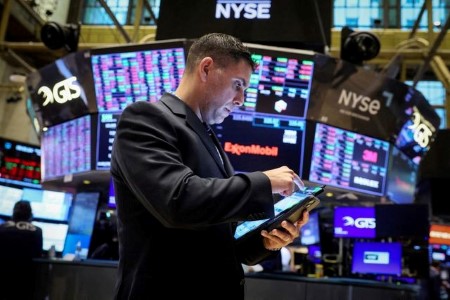




Philippines Trade Update: Exports momentum continues
 DOWNLOAD
DOWNLOAD

Quarterly Economic Growth Release: More BSP cuts to come
 DOWNLOAD
DOWNLOAD

Monthly Economic Update: Fed catches up
 DOWNLOAD
DOWNLOAD


‘Bothersome’ rebound in US yields casts shadow on stocks at record highs

NEW YORK – Treasury yields are on the rise again, presenting a potential obstacle to a US stock rally that has taken major indexes to record highs.
The benchmark 10-year Treasury yield, which moves inversely to bond prices, hit nearly 4.64% this week, its highest level in about a month. It was at 4.55% late on Thursday.
The interplay between stocks and yields has been a key dynamic in markets this year. A sharp rise in yields sent equities tumbling last month, though they came roaring back when data showed cooling inflation and the Federal Reserve suggested it was unlikely to raise interest rates again to tamp down consumer prices. The S&P 500 is up about 10% year to date.
Yet some investors see reasons for yields to keep rising. US growth remains strong, stoking worries the Fed could spark an inflationary rebound if it eases monetary policy too early. One key test comes with Friday’s release of the personal consumption expenditures price index (PCE), which the Fed tracks to determine the pace of inflation.
Persistent concerns about the mounting US fiscal deficit and weak Treasury auctions have also kept yields elevated, as an expected deluge of government debt around the world is set to test investors’ appetite in June.
Robert Pavlik, senior portfolio manager at Dakota Wealth, believes stocks could become more turbulent if the 10-year Treasury yield hits the 4.7% touched last month. So far, the S&P 500 has slipped just over 1% from its record closing high set in May.
At the moment, rising yields are “bothersome, not troubling,” Pavlik said. “If we move higher than (4.7%), then it’s more of a concern that it’s going to have a bigger impact on earnings and potential growth going forward.”
Higher yields translate to higher borrowing rates for consumers and businesses, which could weigh on the economy and companies’ bottom lines.
Elevated yields also pose greater investment competition for stocks, as Treasuries are seen as far less risky because they are backed by the US government.
“If you can earn around 5% in an instrument with a lot lower volatility relative to equities, that should make sense to a lot of investors at these levels,” said Sameer Samana, senior global market strategist at the Wells Fargo Investment Institute.
The WFII recommends investors overweight bonds versus stocks, and is targeting the S&P 500 to end 2024 in a range of 5,100 to 5,300. The index was last at 5,235.48.
The rise in bond yields also could limit the valuation stocks are able to reach, Samana said. The S&P 500 was trading at a price-to-earnings ratio of 20.6, based on analysts’ profit estimates for the next 12 months, according to LSEG Datastream. That is well above the historic average of 15.7.
Other measures also suggest stocks are becoming less attractive.
The equity risk premium, which compares the S&P 500 earnings yield against the 10-year Treasury yield, is around its lowest level since mid-2002, said Keith Lerner, co-chief investment officer at Truist Advisory Services.
“Rising Treasury yields have certainly created more headwinds for the stock market recently,” Matt Maley, chief market strategist at Miller Tabak, said in a note on Thursday.
Fed policymakers have urged patience on rate cuts, saying they need to see several months of data to be sure inflation is heading back down to the central bank’s 2% target. Futures that track the fed funds rate show investors pricing in just 35 basis points of rate cuts this year, according to LSEG data, from more than 150 basis points priced in January.
Some factors that have driven rates higher, such as a robust US economy, can also support stocks. One demonstration of the economy’s strength came as companies reported earnings in recent weeks: S&P 500 earnings were on track to have climbed 8% in the first quarter from a year earlier, according to LSEG IBES.
That is one reason why Tony Roth, chief investment officer at Wilmington Trust, believes the rise in yields has not been “particularly conclusive” for equities so far.
But persistently strong inflation could be problematic, Roth said. “That starts to present a risk for equities and points to higher yields for a much longer period of time.”
(Reporting by Lewis Krauskopf; Editing by Ira Iosebashvili and Richard Chang)
This article originally appeared on reuters.com





 By Reuters
By Reuters